17 Best Privacy Trees for Your Yard
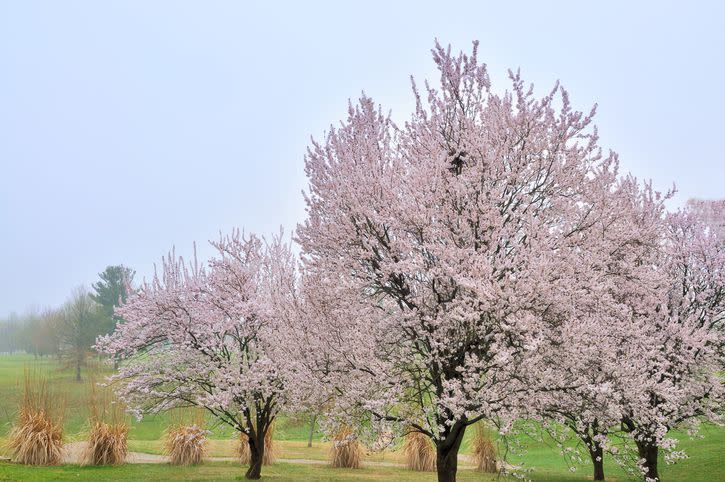
Reviewed by Andrew Hughes
Planting privacy trees adds color and beauty while increasing your property's seclusion, among the many benefits. Choosing the right privacy tree depends on the space you have and the look you desire. Tall, narrow evergreens planted in groupings add stately elegance while deciduous trees provide a wider, softer canopy but lose their leaves in the winter.
Read on for 17 privacy tree options to plant for your backyard oasis.
Warning
Some privacy trees may be toxic to humans and animals, as noted below.
Red Buckeye
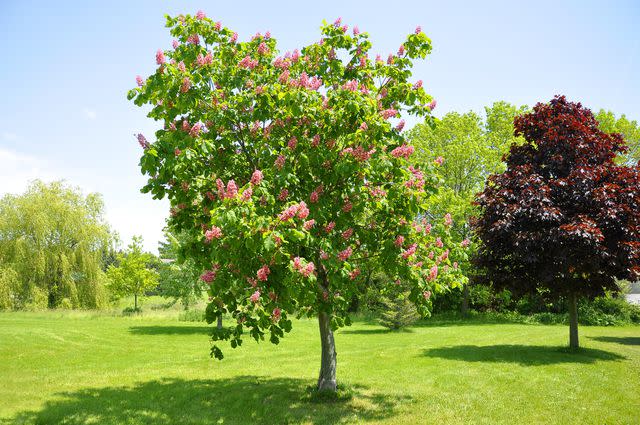
Bob Hilscher / Getty Images
Red buckeye (Aesculus pavia) is one of the most beautiful trees with spring blooms of stunning red flowers. Although deciduous, it's one of the first trees to leaf out with its uniform, squarish canopy. It can grow from 15 to 30 feet wide at maturity and will give a tidy look when planted along a fence line. Its fruits look like rounded, dark-colored nuts with a white center. The tree is toxic to people, pets, and horses.
Name: Red buckeye (Aesculus pavia)
USDA Hardiness Zone: 6-9
Light: Full sun, part shade
Mature Height: 15-20 ft.
Flowering Crabapple
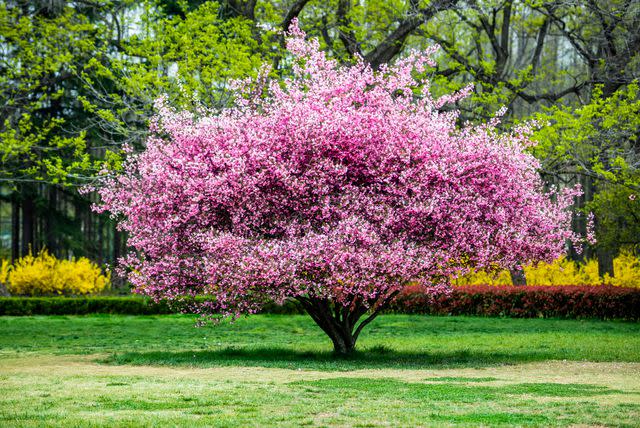
Cheunghyo / Getty Images
Flowering crabapple trees (Malus spp.) feature an open but small spread of just 12 to 20 feet, which makes them an appealing choice for above-fence privacy. Edible fruits and brilliant autumn foliage follow spring displays of white and pink fragrant flowers. Many species and cultivars, including a weeping variety, attract wildlife and add flair to the landscape.
Name: Flowering crabapple (Malus spp.)
USDA Hardiness Zone: 4-8
Light: Full sun
Mature Height: 15-20 ft.
Flowering Cherry
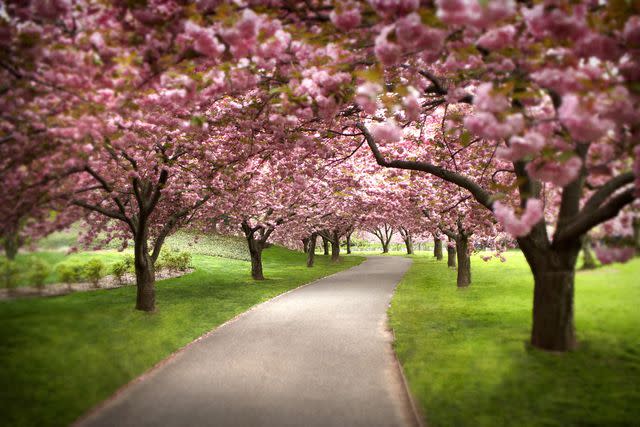
David Sacks / Getty Images
Flowering cherry trees (Prunus serrulata spp.) are famous for their extravagant blooms and serve as decorative plantings in major cities worldwide. The tidy canopy spread 13 to 26 feet. It's abundant with fragrant white, pink, or red blossoms every spring.
They can easily be pruned to a uniform shape. Whether they're planted as a single tree or in groupings, they're guaranteed to add beauty. The flowering cherry tree is considered a short-lived tree, with a 30 to 40-year lifespan, but since it's a rapid grower, you won't wait long to enjoy them. Although it may not produce any fruit, its foliage and flowers are toxic to dogs, cats, and horses.
Name: Flowering cherry, Oriental cherry (Prunus serrulata spp.)
USDA Hardiness Zone: 5-8
Light: Full sun
Mature Height: 15-25 ft.
American Hornbeam
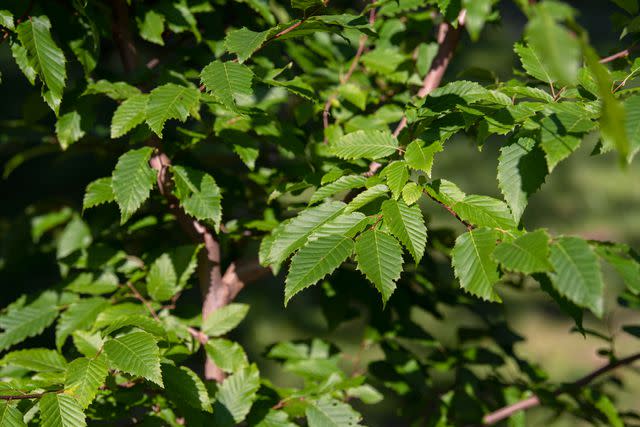
The Spruce / Evgeniya Vlasova
The American hornbeam (Carpinus caroliniana) is adaptable, tall, and has a narrow canopy, which makes it perfect for planting along extended fencing that marks property lines. Its fluted trunk, blue-gray bark, and autumn foliage add interest year-round.
American hornbeam is a slow-growing deciduous tree that requires adequate space but creates a lovely tall border interplanted with flower beds and flowering shrubs. This is a low-maintenance selection with good pest and disease resistance.
Name: American hornbeam, ironwood, musclewood, (Carpinus caroliniana)
USDA Hardiness Zone: 3-9
Light: Full sun to full shade
Mature Height: 20-35 ft.
Purpleleaf Plum
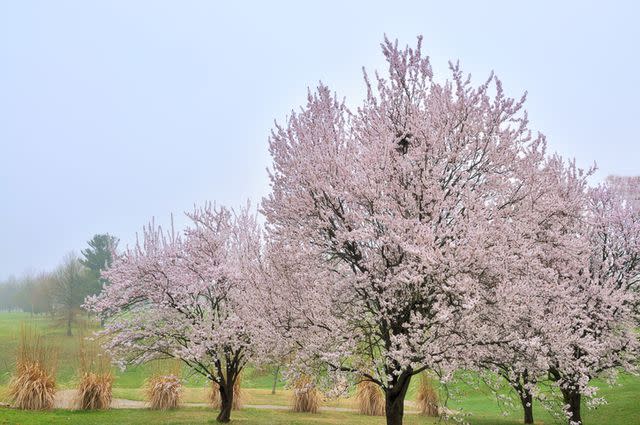
Deep purple leaves adorn the nicely rounded canopy of purpleleaf plum (Prunus cerasifera), adding both height and beauty to your fence line. Fragrant white and pink flowers bloom in spring, which is followed by small berries attracting birds and wildlife. Purpleleaf plum doesn't require much pruning but can struggle in urban environments. Its foliage and seeds are toxic to people and pets.
Name: Purpleleaf plum, cherry plum, (Prunus cerasifera)
USDA Hardiness Zone: 4-9
Light: Full to part sun
Mature Height: 15-25 ft.
American Mountain Ash
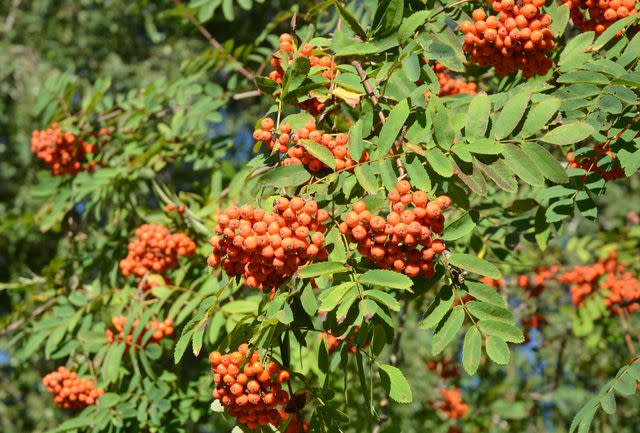
Lex 20 / Getty Images
If you want to add shade along with height to your fence, consider planting American mountain ash (Sorbus americana). This understory tree is tall enough to add privacy with a 20-foot wide canopy that features three season colors. White spring flowers, golden yellow autumn foliage, and edible red-orange fruits add visual enjoyment to backyard gatherings and attract songbirds and pollinators.
Name: American mountain ash, American rowan (Sorbus americana)
USDA Hardiness Zone: 2-6
Light: Full sun, part shade
Mature Height: 15-30 ft.
Crepe Myrtle
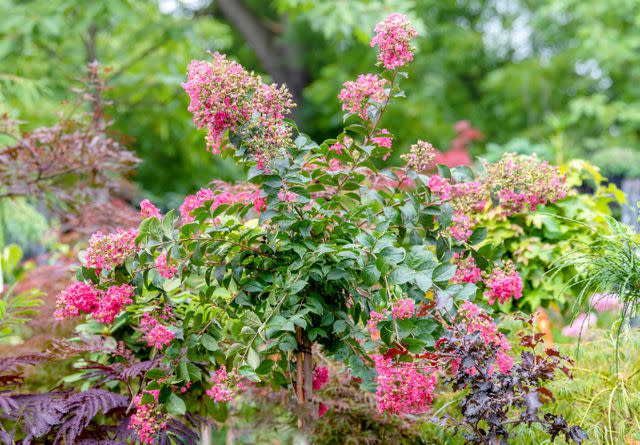
The Spruce / Evgeniya Vlasova
Crepe myrtles (Lagerstroemia indica) offer year-round interest with stunning blooms, colorful autumn foliage, and exfoliating bark. Trees grow rapidly, as much as 24 inches per year, and flower abundantly in spring with fragrant blooms in a range of colors.
A fence is a perfect backdrop for extravagant spring and autumn displays across canopies stretching to 20 feet wide. From the hundreds of types available, choose a taller variety such as 'Natchez' for above-fence privacy.
Name: Crepe myrtle (Lagerstroemia indica)
USDA Hardiness Zone: 6-9
Light: Full sun
Mature Height: 6-25 ft.
Little Gem Magnolia
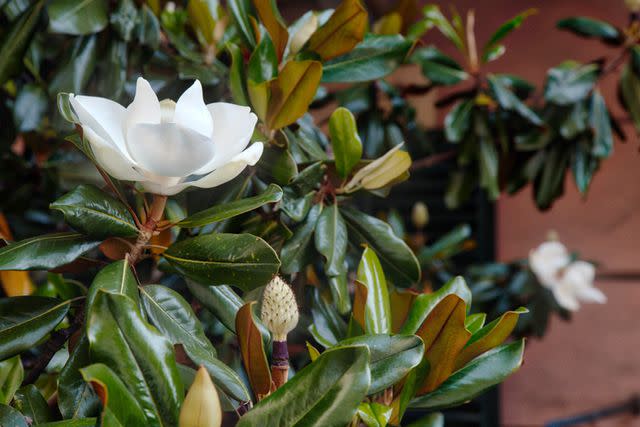
ficio74 / Getty Images
Little gem magnolia (Magnolia grandiflorum 'Little Gem') offers all the best-loved features of the iconic Southern magnolia in a size better suited for adorning a fence. This dwarf cultivar has the same glossy green leaves and fragrant white flowers to create a showy, 10-foot wide canopy of blooms and foliage above your fence line. Little gem is evergreen in its hardiness zones, producing flowers in just two to three years.
Name: Magnolia (Magnolia grandiflorum 'Little Gem')
USDA Hardiness Zone: 6-10
Light: Full sun to light shade
Mature Height: 15-20 ft.
Young's Weeping Birch
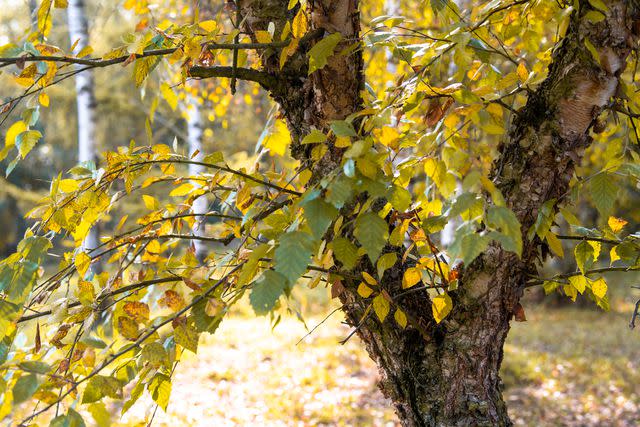
The Spruce / Evgeniya Vlasova
Weeping birch (Betula pendula Youngii) features white bark and trailing branches, adding an element of grace to soften your fence line. Brilliant yellow autumn foliage stands out especially well against stone and brick walls and borders. This dwarf ornamental birch can be planted in groupings to create a dense screen.
Name: Young's weeping birch (Betula pendula Youngii)
USDA Hardiness Zone: 3-9
Light: Full to part sun
Mature Height: 6-12 ft.
Arborvitae 'Emerald Green'
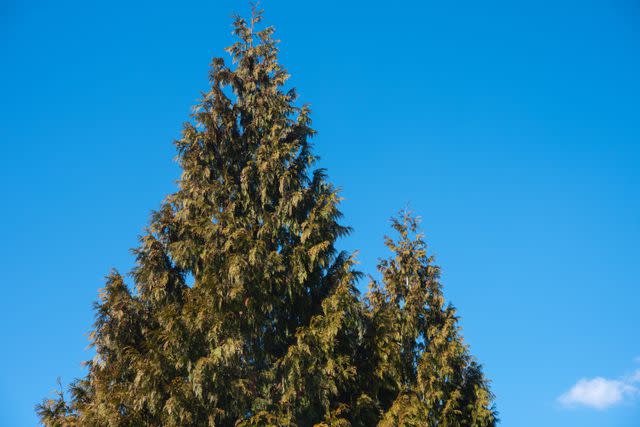
The Spruce / Evgeniya Vlasova
Arborvitae 'Emerald Green' (Thuja occidentalis) is an evergreen cultivar with a narrow, slightly rounded, pyramidal shape. Planted in rows, its uniform appearance adds a permanent, green screen to any fence line. Sprays of glossy green needles and small red-brown cones offer year-round interest.
Name: Aborvitae 'Emerald Green', Smaragd arborvitae, American arborvitae, white cedar (Thuja occidentalis)
USDA Hardiness Zone: 2-7
Light: Full to part sun
Mature Height: 12-20 ft.
Skip Laurel
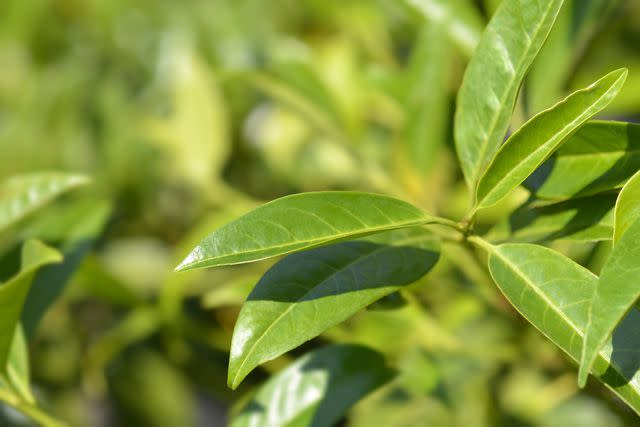
Nahhan / Getty Images
The skip laurel (Prunus laurocerasus), or cherry laurel, is adaptable, low maintenance, and has glossy evergreen foliage to create a perfect tall hedge for privacy along your fence. Fragrant white blossoms in spring are followed by red berries that attract songbirds. This tree fares well in urban conditions with its small size will fit any yard. Foliage and berries are toxic to people, pets, and horses.
Name: Skip laurel (Prunus laurocerasus)
USDA Hardiness Zone: 4-9
Light: Full sun, part shade
Mature Height: 10-25 ft.
Spartan Juniper
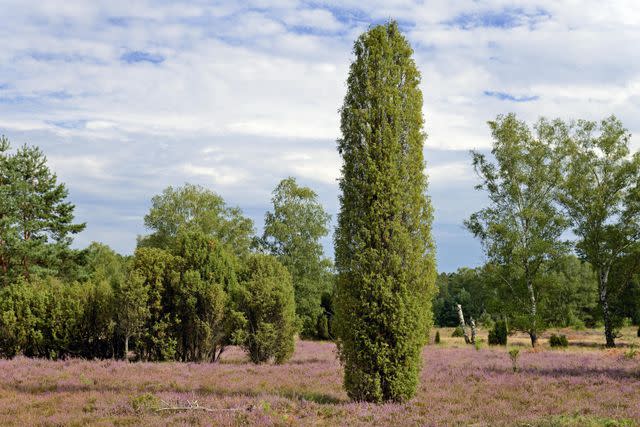
imageBROKER/Frederik / Getty Images
Spartan juniper (Juniperus chinensis 'Spartan) features a narrow, pyramidal shape that fits well against a fence even in the smallest yards. This evergreen adapts to most well-draining soil types and is drought and salt-tolerant. Trees naturally develop an attractive form but can easily be pruned to any desired shape, including topiary.
Name: Spartan juniper (Juniperus chinensis 'Spartan')
USDA Hardiness Zone: 5-9
Light: Full to part shade
Mature Height: 15 ft.
Dwarf Italian Cypress

The Spruce / K. Dave
Dwarf cultivars of the long-lived Italian cypress tree (Cupressus sempervirens) give your fence an elegant, formal look with sprays of dark gray-green needles on short, upright branches. A narrow spread of 5 feet or less adds height and structure when planted in groupings or rows. Look for 'Swane's Golden', 'Swane's Variegated', and 'Tiny Tower' cultivars for the perfect size to adorn your privacy fence.
Name: Dwarf Italian cypress (Cupressus sempervirens)
USDA Hardiness Zone: 7-10
Light: Full to part sun
Mature Height: 10-30 ft.
Dragon Lady Holly
Dragon lady holly (Ilex x aquipernyi) is a broadleaf evergreen tree with the right height and shape for bordering a fence line. This holly is drought tolerant and adapted to poor soil as long as it drains well. It fares best in cooler temperatures, so protection from afternoon heat is recommended. Plant both male, 'Aquipern', and female, 'San Jose', cultivars for white flowers and red berries that bring in birds and pollinators. Holly berries are toxic to people and pets.
Name: Dragon lady holly, aquipern holly, (Ilex x aquipernyi)
USDA Hardiness Zone: 5-7
Light: Full sun to part shade
Mature Height: 10-20 ft.
Black Dragon Japanese Cedar
The Japanese cedar, 'Black Dragon' (Cryptomeria 'Black Dragon'), will transform your privacy fence into a concept garden border with its unique shape and color. Its irregular dense branching and foliage mature from bright green to nearly black giving it a distinct look to your hardscape. Black Dragon shapes itself without pruning and is pest, disease, and drought-resistant. Black Dragon is a much smaller tree than the common Japanese cedar tree which can grow to 60 feet tall.
Name: Japanese cedar (Cryptomeria 'Black Dragon')
USDA Hardiness Zone: 5-9
Light: Full to part sun
Mature Height: 6-10 ft.
Viburnum
Viburnums are popular flowering shrubs with endless cultivars to choose from, including evergreen types and deciduous varieties. The plant can be grown as a shrub or small tree. Flowers will be flat clusters of florets, blooms that look like lace-cap hydrangeas, or snowball-like clusters. Viburnums bloom from early spring through June and deciduous varieties offer fall color.
Name: Viburnum (Viburnum spp.)
USDA Hardiness Zone: 2-9
Light: Full, partial
Mature Height: 3-20 ft.
Fragrant Tea Olive
Fragrant tea olive (Osmanthus fragrans), an evergreen broadleaf shrub or small tree, is a dense, multi-stemmed plant with elongated dark green leathery leaves, producing small but showy clusters of extremely fragrant white or yellow flowers in the spring. Its delightful scent resembles jasmine, orange blossoms, ripe peaches, or apricots. Fragrant tea olive is somewhat of a slow grower, adding 4 inches to 1 foot per year. Once established, it has a long lifespan of about 25 to 50 years.
Name: Fragrant tea olive (Osmanthus fragrans)
USDA Hardiness Zone: 8-11
Light: Full, partial
Mature Height: 20–30 ft.
Choosing a Privacy Tree
The amount of space available, whether you want to create a solid border, or add decoration to the existing hardscape will determine what screening tree you should choose.
Most evergreens naturally form an attractive pyramidal or columnar shape with permanent color year-round. Varieties that reach maturity at 15 to 20 feet form dense hedges for borders and screens when spaced appropriately. Upright growth and narrow crowns create a structured look to your landscape.
Deciduous trees require more space and work better to soften hardscapes like wood or stone fencing. They lose their full appearance in winter but offer greater choices for aesthetic appeal. Wide canopies provide shade along with flowers, fragrances, fruits, and autumn colors. Deciduous trees attract plenty of pollinators, birds, and other wildlife.
Tips For Planting Privacy Trees
Plant screening tree recommended distances from fencing, structures, and other trees according to cultivar. The rule of thumb is to note the mature spread of the tree and plant that same distance from your fence.
Always consider the mature height, width, and potential canopy spread of a tree. Be aware of overhead utility lines and other landscape elements your mature tree could encroach upon.
Many small flowering trees add seasonal color and beauty to a fence line. Look for cultivars with spreading canopies and interesting leaves and bark.
When considering evergreens, make sure the cultivar you choose grows to your desired height. Many species include tall, towering trees with dwarf cultivars that fit better along a privacy fence.
Flowering trees may produce berries that can be messy on driveways and walkways. Avoid planting this variety in high-traffic areas.
Larger deciduous trees can extend onto adjacent property. Consider what is on the other side of the fence before landscaping your property lines and impacting your neighbor.
Frequently Asked Questions
What type of tree is best for privacy?
The answer depends on what you're looking for in your landscape design. Crepe myrtles are a beautiful addition to any property while arborvitae remain green year-round. When planted closely, it'll create a top-to-bottom screen against fencing and along property lines.
How tall should a privacy tree be?
Prvacy trees can be any size but look for trees with mature heights of 30 feet or less rated for your growing zone. Consider how much time you can devote to maintenance and whether your selection has pest and disease resistance.
What is the best evergreen tree for privacy?
You will find many evergreen trees that make excellent privacy trees, including arborvitae to yews and privets.
What type of privacy tree grows the fastest?
Fast-growing cultivars of arborvitae, pine, and Japanese cedar can reach heights of 50 to 60 feet at maturity and provide adequate screening in three to five years. The drawback is they can quickly outgrow a designated space. Also consider fast-growing flowering shrubs, such as lilac bushes or mock orange.
How close to a fence can you plant a tree?
Evergreens can usually be planted closer to fencing, however, it's a good idea to leave several feet of space to allow access. A good rule of thumb is to note the mature spread of the tree and plant it the same distance from the fence.
10 Best Evergreens for Hedges and Privacy Screens
Read the original article on The Spruce.

